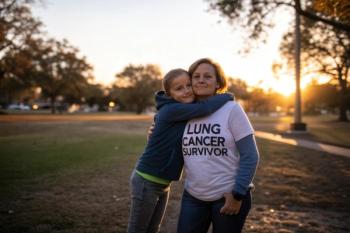
U.S. Lung Cancer Survival Improves to Nearly 30%, but Funding Cuts Threaten Progress
Key Takeaways
- Lung cancer survival rates have improved significantly, but funding cuts threaten future progress in research and treatment.
- Disparities in lung cancer outcomes persist, with people of color experiencing worse outcomes at nearly every stage of care.
The national five-year survival rate for lung cancer has climbed to nearly 30%, up from 18% from eight years ago, according to the American Lung Association.
Advances in lung cancer research, screening and treatment are helping more Americans live longer after diagnosis, according to the American Lung Association’s new State of Lung Cancer 2025
Now in its eighth year, the report reveals that nearly 227,000 people will be diagnosed with lung cancer this year. Rhode Island leads the nation with a survival rate of 37.6%, while Alabama has the lowest at 22.7%.
Advances in research and early detection have transformed what it means to be diagnosed with lung cancer, according to Harold Wimmer, M.S., president and CEO of the American Lung Association. “In just the past eight years since we launched this report, the five-year survival rate has gone from 18% to nearly 30%,” he stated in a
The lung association credits much of this progress to federally supported research and public health programs but warns that recent funding cuts could endanger future gains. Research funded by the National Institutes of Health has produced 73 new lung cancer treatments in the past decade, and programs at the Centers for Disease Control and Prevention have been key to reducing tobacco use. Reductions in staffing and budgets at NIH and CDC, along with deep cuts to Medicaid and Affordable Care Act coverage, could weaken efforts to prevent and treat lung cancer.
Despite the progress, major disparities persist. People of color diagnosed with lung cancer face worse outcomes at nearly every stage of care. Compared with White individuals, Black people are 13% less likely to be diagnosed early, 19% less likely to receive surgery, 11% more likely to go untreated, and 13% less likely to survive five years after diagnosis. Indigenous people face similar challenges, while Latino and Asian individuals experience mixed outcomes.
The report also finds that early diagnosis remains uncommon nationwide. Only 28.1% of cases are caught early, when the five-year survival rate can reach 65%. Just 18.2% of those eligible for a low-dose CT scan were screened in 2022, even though research shows the test can reduce lung cancer deaths by 20%.
Comprehensive biomarker testing is one of the most promising advances in lung cancer care. It identifies changes in a tumor’s DNA, allowing clinicians to choose targeted treatments with fewer side effects. Access, however, remains uneven. As of August 2025, 17 states require full insurance coverage, five have partial coverage, and 28 states and Washington, D.C., have none.
The lung association is calling on policymakers and the public to expand insurance coverage for biomarker testing to advance health equity and make cancer care more accessible. Broader coverage would help more people benefit from precision medicine and reduce the financial burden of treatment.
Here are some more details from the report:
- Latino individuals with lung cancer were 18% less likely to be diagnosed early and 26% more likely to not receive any treatment compared to White individuals. However, they were 2% more likely to receive surgical treatment and equally likely to survive five years compared to White individuals.
- Utah has the nation’s lowest lung cancer incidence rate of 25.3 cases per 100,000 population, while Kentucky has the highest at 84.1 cases per 100,000 population. The national rate is 52.8 cases per 100,000.
- Approximately 1 in 5 (21%) cases of lung cancer do not receive any treatment. “Some of these reasons may be unavoidable,” says the lung association report, “but no one should go untreated because of lack of provider or patient knowledge, lung cancer stigma, fatalism after diagnosis, or cost of treatment.”
Newsletter
Get the latest industry news, event updates, and more from Managed healthcare Executive.




















































